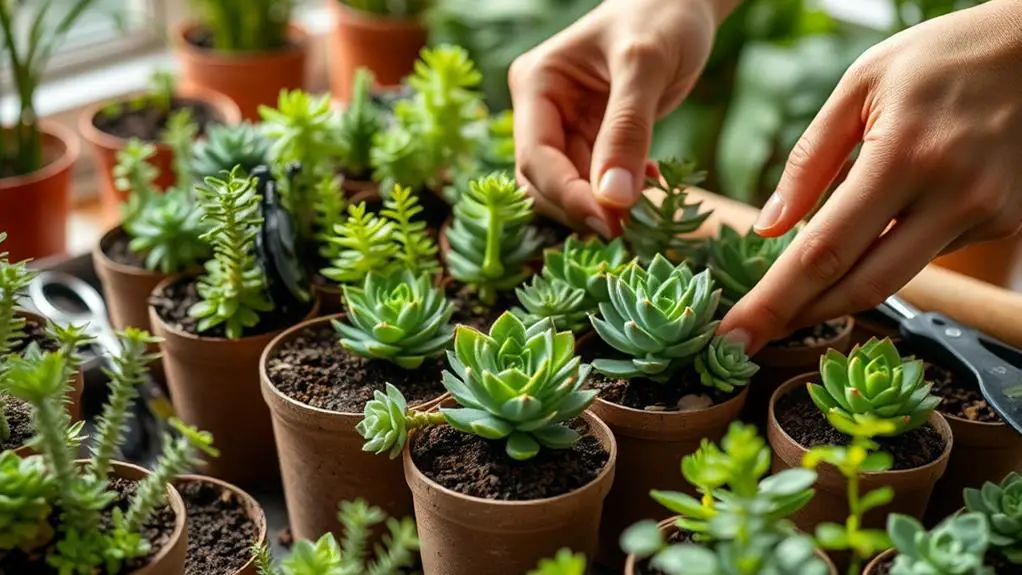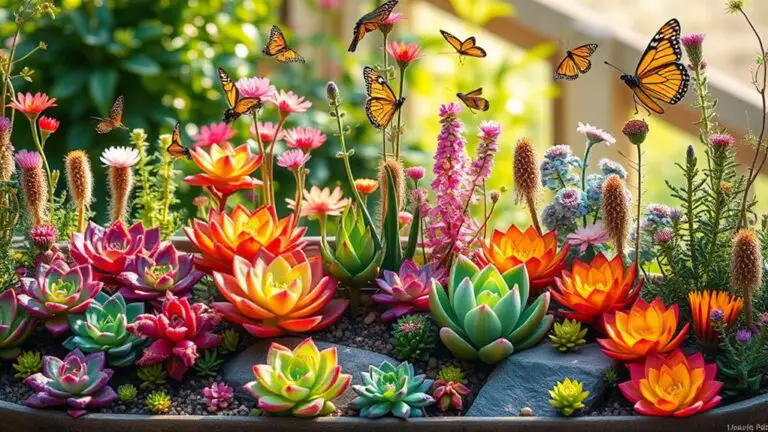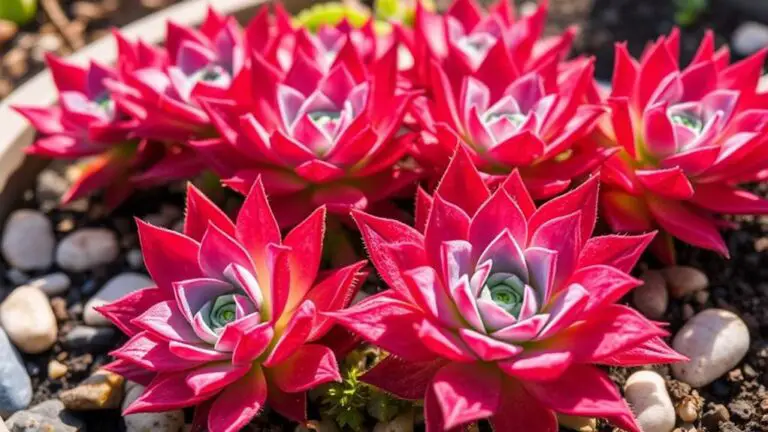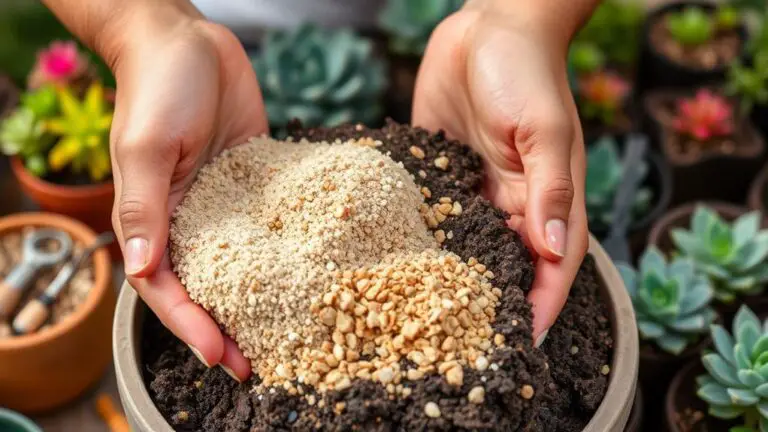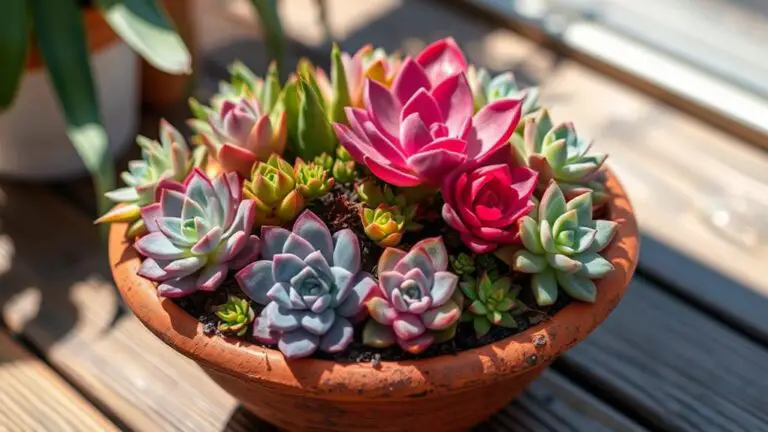Fixing Stretched Out Succulents: A Step-by-Step Guide
You've noticed your succulents have become leggy and stretched out, losing their compact and vibrant appearance. This often happens when they're not getting enough light, causing them to reach out in search of better conditions. But don't worry, you can restore them to their former glory with a few simple steps. We'll guide you through evaluating their current state, making necessary cuts, and ensuring they thrive in the future. Ready to transform your succulents and bring back their healthy, attractive look? Let's start with understanding why they stretch out in the first place.
Causes of Leggy Succulents
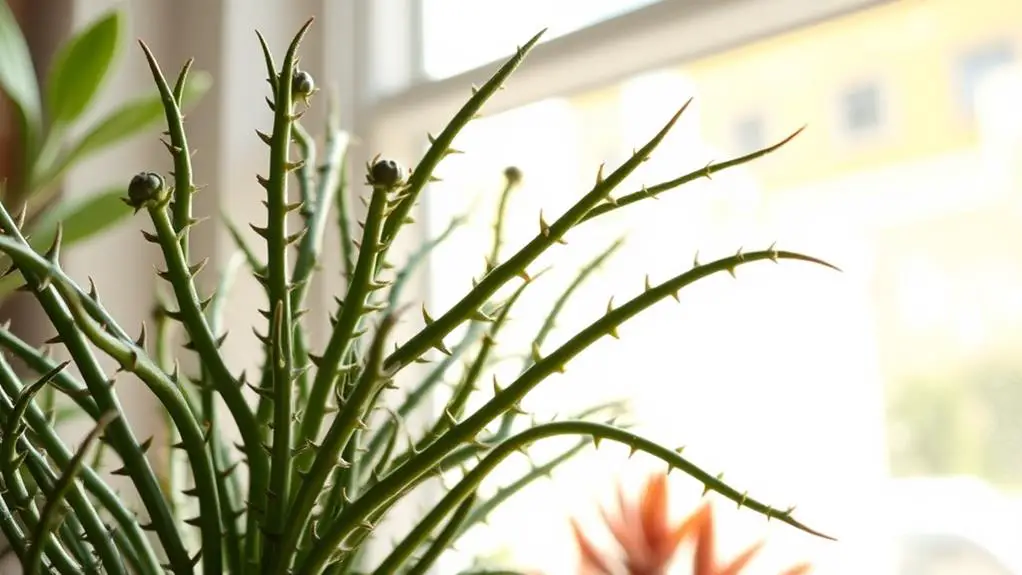
Leggy succulents are typically caused by insufficient light exposure, which makes the plants stretch toward any available light source. When your succulents don't get much light, they try to grow towards it, resulting in elongated stems and sparse leaves. This stretching is known as becoming "leggy."
Different types of succulents have varying light needs. For example, fast-growing succulents like Jade plants will stretch more quickly if they don't receive enough illumination.
Indoor succulents often face this issue since they mightn't get as much light as they need, especially in rooms with poor natural lighting. Without enough light, you might notice your succulents losing their compact, rosette shape. Instead, they develop pronounced spacing between leaves and curved stems, which are clear signs of leggy growth.
To avoid leggy succulents, it's vital to monitor their light conditions regularly. You can reposition your plants to sunnier spots to guarantee they receive adequate light. Doing so helps them grow healthier and maintain their compact form.
Identifying Stretching Symptoms
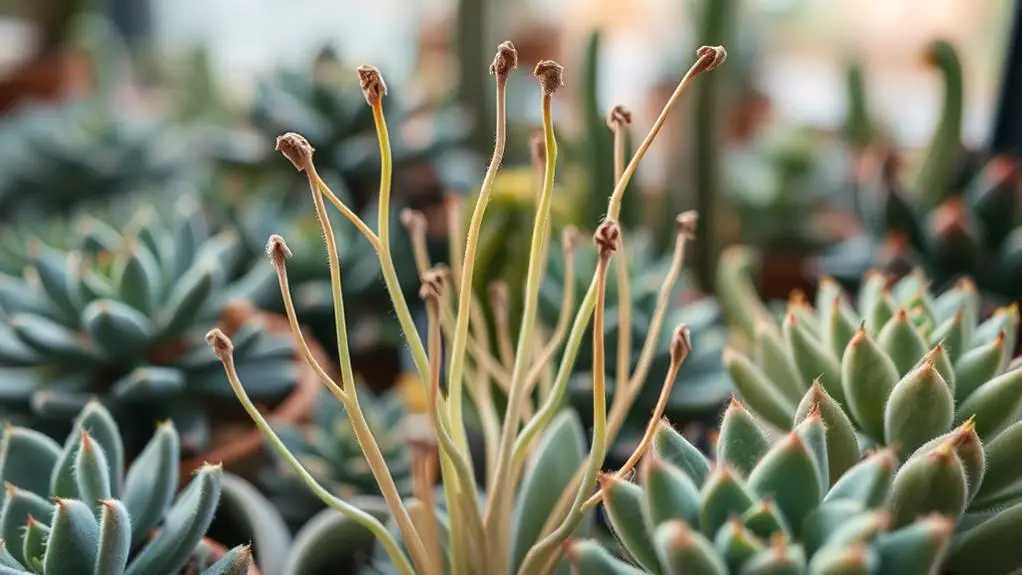
Recognizing the early signs of stretching in your succulents is essential to prevent further leggy growth. When succulents start stretching, it's a clear indication that they're not getting enough light.
Here are the first signs to look out for:
- Elongated stems: One of the most noticeable symptoms is when stems grow longer and the spacing between leaves becomes more pronounced.
- Loss of rosette shape: Especially in Echeveria varieties, you'll see the compact, beautiful rosette shape disappear as the plant stretches.
- Curved or bent stems: Succulents often bend toward a light source, resulting in a curved or tilted appearance.
- Rapid growth in certain plants: Fast-growing succulents like Jade plants will stretch quickly if they don't get enough light, unlike slower-growing types like cacti.
- Indoor vulnerability: Indoor succulents are particularly at risk because they often don't get enough natural sunlight.
Preparing for Pruning
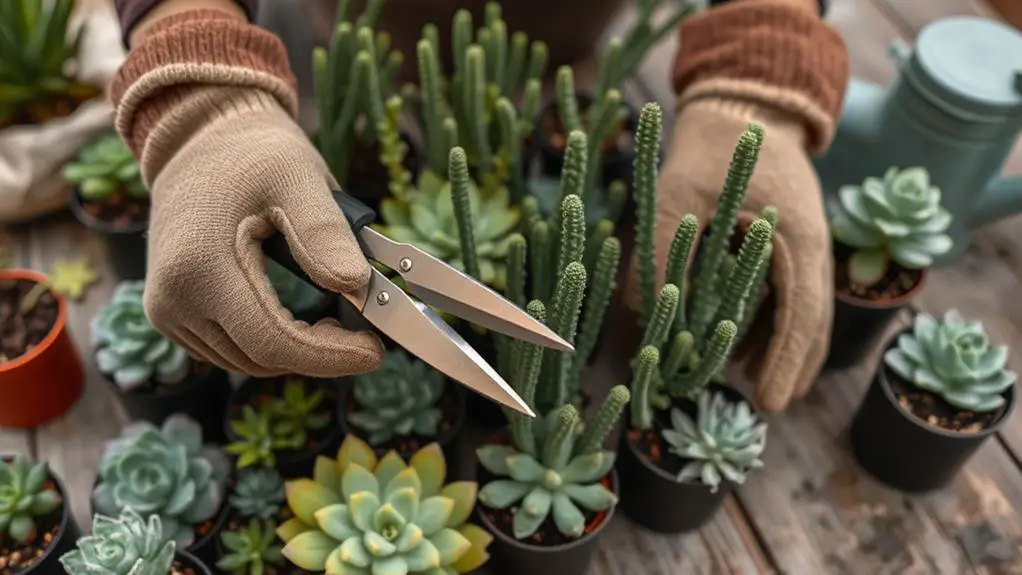
Before you start pruning your succulent, gather clean, sharp pruning shears or scissors to make precise cuts and avoid infection.
Identify which parts of the plant need trimming, especially elongated stems and any dead or unhealthy leaves.
Set up a clean workspace to keep everything organized, and have fresh, well-draining soil ready for replanting cuttings.
Essential Pruning Tools
Proper preparation is the cornerstone of successful succulent pruning, and having the right tools on hand is essential. You need specific tools to guarantee clean and precise cuts, which will keep your plants healthy and thriving.
Sharp pruning scissors are vital for making clean cuts, helping to prevent damage and reduce the risk of infection. They're perfect for trimming smaller stems and leaves. For thicker stems, a sterile knife is indispensable. Be certain to disinfect the blade before use to maintain plant health and prevent disease.
Here's a handy list of tools you should gather before starting:
- Sharp pruning scissors: Ideal for clean, precise cuts.
- Sterile knife: Necessary for cutting thicker stems, always disinfect beforehand.
- Chopsticks: Useful for repositioning leaves or stems without causing harm.
- Clean workspace: Prevents cross-contamination and keeps your plants safe.
- Tool maintenance supplies: Regularly sharpen and sterilize your tools for effective pruning.
Having these tools will make the pruning process smoother and more efficient.
Identifying Stretching Signs
Now that you're equipped with the right tools, let's focus on spotting the signs that your succulents need pruning due to stretching.
Look for elongated stems and pronounced gaps between leaves. These are classic signs of stretching, indicating your plant is reaching for insufficient sunlight.
Echeveria succulents, for instance, may lose their lovely rosette shape and develop curved, leggy stems due to inadequate light exposure.
It's essential to regularly monitor your indoor succulents for sparse foliage or aerial roots. These signs also point to insufficient sunlight and signal that your plant is struggling.
Fast-growing varieties, such as Jade plants, will show signs of stretching more quickly than slower-growing cacti.
Early identification is vital for these types, as it allows you to address the issue before it worsens.
Check your plants' light conditions often. Confirm they're in well-lit areas, whether from natural sunlight or supplemental grow lights.
By keeping a keen eye on these signs, you can act promptly and give your succulents the care they need to thrive.
It's all about paying attention and making small adjustments to keep your plants happy and healthy.
Preparing Cutting Surfaces
Getting ready for pruning your succulents starts with ensuring your cutting surfaces and tools are spotless. First, grab your pruning shears, scissors, or knives and clean them thoroughly with rubbing alcohol. This step is essential to prevent spreading any diseases to your succulents.
Next, prepare a clean, flat surface to work on. Cover it with a layer of newspaper or a cutting mat to catch any leaves or debris that might fall.
You'll also want to gather all your materials before you start. Make sure you have pots, fresh well-draining succulent or cactus potting soil, and a spray bottle for watering after replanting.
If you're working with multiple succulents, label each one to keep track of their specific needs and avoid confusion. Organize your workspace so you have easy access to everything you need. This will help you work smoothly and reduce the risk of contamination.
Here's a handy checklist to get you started:
- Clean and sterilize cutting tools with rubbing alcohol.
- Prepare a clean, flat surface with newspaper or a cutting mat.
- Gather pots and fresh well-draining potting soil.
- Keep a spray bottle nearby for post-replanting watering.
- Label succulents to track their care requirements.
Trimming Overgrown Stems

One essential step in revitalizing your stretched-out succulents is trimming overgrown stems. To start, grab a pair of clean, sharp pruning shears. These will help you make precise cuts, which are vital for healthy growth.
You'll want to trim the overgrown stems to a suitable length for replanting, making your cuts just above a leaf node. This guarantees ideal regrowth.
Next, remove any excess leaves below the main rosette. This will give your succulent a tidy appearance and promote a balanced rosette shape. It's important to aim for this balance to encourage healthy growth.
Once you've trimmed the stems, allow them to dry for 1-2 days. This drying period helps prevent root rot when you eventually replant them in fresh, well-draining succulent or cactus potting soil.
Replanting Techniques
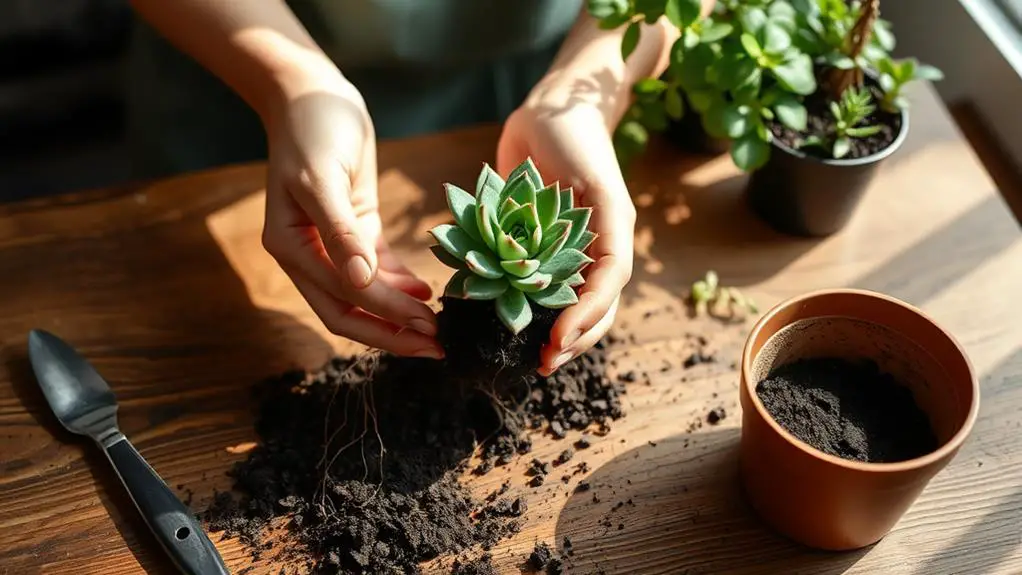
When replanting your stretched-out succulents, start by using clean, sharp pruning shears to cut the stem to a healthy length, making sure to remove excess leaves below the main rosette.
Let the cut ends dry for 1-2 days before placing them in fresh, well-draining soil to prevent root rot.
After replanting, don't water your succulent for a week to help it adjust and reduce the risk of overwatering.
Cutting and Pruning
To tackle leggy succulents, start by using clean, sharp pruning shears to cut the stem to a suitable length for replanting, making sure the cut is just above a leaf node for ideal growth. This helps the plant focus its energy on new, healthy growth.
When you're cutting and pruning, be sure to remove any excess leaves below the main rosette. This tidies up your succulent and keeps its rosette shape looking neat.
Next, allow the cut ends to dry for 1-2 days. This step is essential to prevent root rot. Once the ends have dried, you can replant them. But hold off on watering for at least a week! This helps the plant adjust to its new surroundings without the risk of overwatering.
Here are some key tips to keep in mind:
- Use clean, sharp pruning shears for the best cuts.
- Remove dead leaves and excess foliage for a cleaner look.
- Let cut ends dry before replanting to prevent root rot.
- Avoid watering for a week after replanting.
- Regularly monitor and prune to encourage new growth and prevent legginess.
Soil and Drainage
Ensuring the right soil and drainage for your succulents is essential for their health and longevity. Start by using fresh, well-draining succulent or cactus potting soil. This type of soil provides proper aeration and controls moisture, which is vital for preventing root rot.
After cutting and pruning your stretched-out succulents, it's important to let the cut stems dry for 1-2 days. This drying period forms calluses on the cuts, helping to avoid excess moisture and potential rot.
When you're ready to replant, leave some stem exposed above the soil line. This practice helps prevent rot while still allowing the plant to establish its roots. If you have overcrowded rosettes, consider separating them and planting each in individual pots. This allows for better airflow and healthier growth.
Regularly check the soil moisture levels after repotting. Newly planted succulents typically need less frequent watering as they acclimate to their new environment. Overwatering can lead to excess moisture, which is detrimental to succulents.
Post-Replanting Care
Post-replanting care is essential for guaranteeing your succulents thrive in their new environment. To prevent future leggy growth, place your plants in a spot with ample light. If natural sunlight is insufficient, consider using grow lights to provide an adequate light source.
Water your replanted succulents sparingly for the first week. This helps them acclimatize and avoids root rot. Typically, you should wait at least a week before giving them much water.
After the initial period, adjust your watering schedule to every two weeks during the growing season and extend it to every four weeks in winter.
Regular trimming of leggy growth can encourage new, compact growth patterns. This helps maintain the plant's aesthetic and health. Remember to be patient, as it may take time for your succulents to bounce back fully.
Here's a quick guide to keep things on track:
- Provide ample light: Guarantee a bright environment or use grow lights.
- Water sparingly: Allow at least a week before the first watering.
- Adjust watering frequency: Every two weeks in growing seasons, four weeks in winter.
- Trim regularly: Encourage compact growth.
- Fertilize during active growth: Support healthy recovery.
With these steps, your succulents will have the best chance to flourish.
Post-Pruning Care
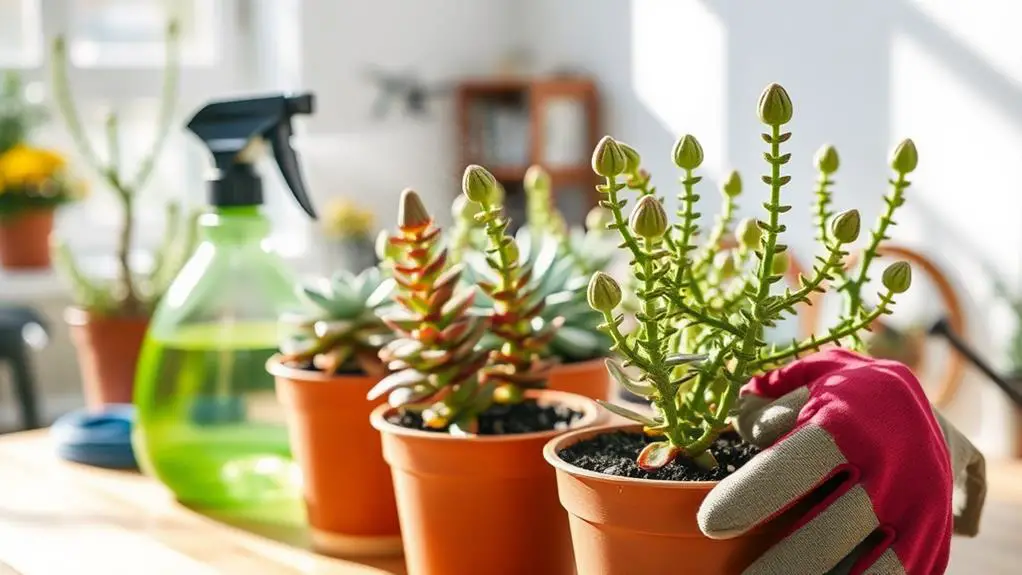
Once you've pruned your stretched-out succulents, it's essential to allow the cut ends to dry for 1-2 days. This step is important in post-pruning care as it helps the ends form a protective callus. By doing so, you prevent root rot when you replant them.
After the drying period, replant your succulents in well-draining soil.
For the first week, water your newly replanted succulents sparingly. This helps them adjust to their new environment without overwhelming their roots. Keep a close eye on the soil moisture; overwatering is a common mistake. Every two weeks is usually enough, but in winter, you can water even less frequently.
If your succulents have shallow roots, a spray bottle can help you control water distribution better.
Ensure your pruned succulents receive plenty of sunlight. Bright, direct light is ideal, or you can use grow lights. This prevents future stretching and encourages healthy new growth.
Remember to fertilize during the growing seasons to support their recovery and encourage robust new growth. Be patient, as it might take some time for your succulents to bounce back from legginess. With a bit of care, they'll thrive again!
Propagation Methods

After caring for your pruned succulents, you might wonder what to do with the leftover leaves and stem pieces. Don't toss them out! You can propagate these parts to grow new indoor plants and enhance your collection. Here's how:
- Leaf Propagation: Save healthy leaves from your pruned succulents and place them on moist soil in a propagation tray. This encourages new roots and growth.
- Crassula Cuttings: Insert cut stems back into the soil around the original plant to promote a fuller appearance and healthy growth. Simply make a little hole in the soil and gently place the cutting in.
- Echeveria: Dissect into individual leaves or rosettes. Replant these to create new plants and improve the overall look of your arrangement.
- Sedum Leaves: These are particularly effective for propagation. Place them on moist soil and they'll easily root and grow into new plants.
- Regular Monitoring: Keep an eye on your new cuttings. Provide adequate light and moisture to guarantee successful propagation and growth.
Long-Term Maintenance
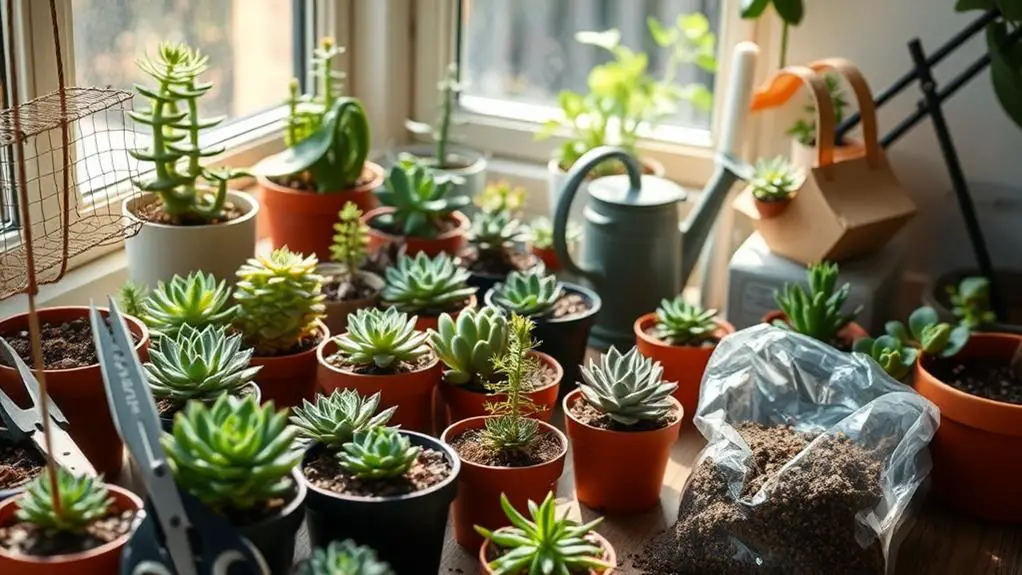
Ensuring the long-term health of your succulents involves a few key practices that will keep them vibrant and thriving. First, provide enough sunlight. Succulents need at least 6 hours of bright, direct sunlight daily to prevent future stretching. If natural light is scarce, consider using grow lights, especially during shorter days.
Next, water your succulents every 2 weeks during the growing season, reducing to every 4 weeks in winter. Be mindful of humidity and soil moisture to avoid overwatering. Regularly check for signs of legginess or decay. Trim back any overgrown stems and remove dead leaves to maintain a healthy rosette shape.
Fertilizing during active growth seasons with diluted fertilizer will support robust growth. Avoid fertilizing during dormancy to prevent stress. Finally, practice patience. It might take time for your succulents to recover from previous leggy growth. Observe how they respond to light and water adjustments for future care strategies.
| Task | Frequency |
|---|---|
| Sunlight Exposure | 6 hours daily |
| Watering | Every 2 weeks (growing) |
| Trimming | Regularly as needed |
Frequently Asked Questions
How to Fix Succulent Stretching?
To fix succulent stretching, move your plant to a brighter spot or use grow lights. Prune elongated stems, let the cut ends dry, replant in well-draining soil, and avoid watering for a week to encourage new growth.
Where Do You Cut Stretched Succulents?
Cut stretched succulents just above a healthy leaf or rosette. Make sure the cut is clean to promote healing. Remove leaves below the rosette for a compact look. Use sharp, clean shears to avoid damage and infection.
How Do I Make My Succulents Grow Wider?
Make certain your succulents get bright light, ideally from a south-facing window or grow lights. Prune leggy stems to encourage bushier growth. Maintain proper watering, fertilize during the growing season, and monitor the plant's environment regularly.
What Does a Stretched Succulent Look Like?
A stretched succulent looks tall with elongated stems and significant spacing between leaves. You'll notice it growing towards the light, often with a distorted shape and sparse leaves at the top, sometimes even showing aerial roots.
Conclusion
You've got this! With the right steps, your stretched-out succulents will bounce back beautifully. Just remember to give them plenty of light, prune carefully, and replant in well-draining soil. Keep an eye on your watering habits and adjust as needed. Don't forget, propagation is a great way to grow new plants from your trimmings. Stick to these tips, and your succulents will thrive in no time. Happy gardening!

